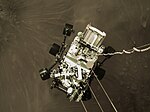C/2021 A1 (Leonard)
 Long-exposure composite image of comet C/2021 A1 | |
| Discovery | |
|---|---|
| Discovered by | Greg J. Leonard |
| Discovery date | 3 January 2021[1] |
| Designations | |
| C4AGJ62 | |
| Orbital characteristics | |
| Orbit type | long period (inbound) hyperbolic (outbound) |
| Aphelion | ≈3700 AU (barycentric epoch 1950)[2] |
| Perihelion | 0.6151 AU |
| Eccentricity | 0.99966 (barycentric epoch 1950)[2] 1.00004 (barycentric epoch 2100) |
| Orbital period | ≈80000 yr (inbound)[2] |
| Inclination | 132.68° |
| Next perihelion | 3 January 2022 (followed by ejection) |
| Earth MOID | 0.231 AU (34.6 million km)[3] |
| Jupiter MOID | 0.296 AU (44.3 million km) |
| Comet total magnitude (M1) | 5.3 |
C/2021 A1 (Leonard) is an inbound long period comet[4] discovered by G. J. Leonard at the Mount Lemmon Observatory on 3 January 2021 (a year before perihelion) when the comet was 5 AU (750 million km) from the Sun.[1] Jupiter's orbit (5 AU from the Sun) is at the frost line where methanol (CH3OH) and water start sublimation.[5] This is the first comet discovered in 2021 and has a retrograde orbit. On 12 December 2021 the comet will be 0.233 AU (34.9 million km) from Earth and on 18 December 2021 will be 0.028 AU (4.2 million km) from Venus.[3] It will make its closest approach to the Sun on 3 January 2022. It may reach naked eye visibility in December 2021.[6] At an apparent magnitude of 4, it should be a good binocular comet. On 10 October the comet showed a short but dense dust tail.[7] As of mid-November the comet has a total magnitude (coma+nucleus) of around 9.[8]
On the morning of 6 December 2021 the comet will be about 5 degrees from the star Arcturus. On 14 December 2021 the comet will be 14.7 degrees from the Sun[9] and will quickly become better seen from the southern hemisphere. The forward scattering of light could cause the comet to brighten to as much as magnitude 1.[8]
C/2021 A1 has been inside of the orbit of Neptune since May 2009.[10] Using an epoch of 1950 which is well before the comet entered the planetary region of the Solar System, a barycentric orbit solution suggests the comet had roughly a 80 thousand year orbital period.[2] Therefore the comet had spent the last 40 thousand years inbound from approximately 3,700 AU (550 billion km). After perihelion the comet will be ejected from the Solar System. The barycentric orbit will remain hyperbolic after September 2022.[2]
References
- ^ a b "MPEC 2021-A99 : COMET C/2021 A1 (Leonard)". Minor Planet Center. Retrieved 2021-01-10.
- ^ a b c d e Horizons output. "Barycentric Osculating Orbital Elements for Comet C/2021 A1 (Leonard)". Retrieved 2021-01-13. (Solution using the Solar System's barycenter (Sun+Jupiter). Select Ephemeris Type:Elements and Center:@0) Epoch 1950 has PR= 2.91E+07 / 365.25 = 79700 years
- ^ a b "PL Small-Body Database Browser: C/2021 A1". JPL. Retrieved 2021-09-29.
- ^ CBET 4907: original 1/a = +0.000575 (long-period) and future 1/a = -0.000030 (hyperbolic). The orbital energy is inversely proportional to negative semi-major axis. Objects in hyperbolic orbits have negative semi major axis, giving them a positive orbital energy.
- ^ "Figure 3 Chandler (2020)". doi:10.3847/2041-8213/ab7dc6. S2CID 212657575.
{{cite journal}}: Cite journal requires|journal=(help)CS1 maint: unflagged free DOI (link) - ^ Magnitude estimate – Seiichi Yoshida
- ^ "How Bright Will Comet Leonard Get?". Sky & Telescope. 2021-10-13. Retrieved 2021-10-20.
- ^ a b "C/2021 A1 (Leonard)". Gideon van Buitenen. Retrieved 2021-11-16.
- ^ Horizons output. "Solar elongation Comet C/2021 A1 (Leonard) in mid-December 2021". Retrieved 2021-10-17. Sun-Observer-Target (S-O-T)
- ^ Neptune has perihelion (closest approach to the Sun) at 29.8 AU. C/2021 A1 has been inside that distance since May 2009.



